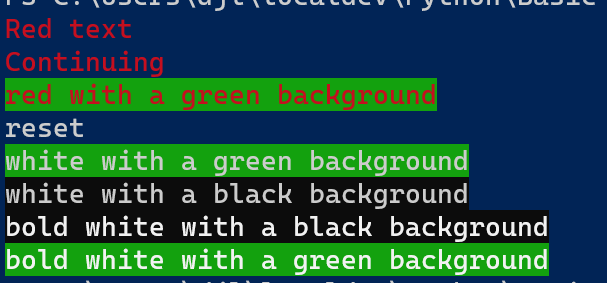Learning Python with Advent of Code Walkthroughs
Dazbo's Advent of Code solutions, written in Python
The Python Journey - Colours

Useful Links
EnumColorama (PyPI)LoggingExtending clases
Page Contents
Creating Our Own Colours Class
Sometimes we want to add a bit of colour to our terminal output. One way we can do this is by by using ANSI escape sequences. Here, I’ve created a Colours class by extending Enum:
from enum import Enum
class Colours(Enum):
""" ANSI escape sequences for coloured console output. E.g.
print(Colours.GREEN.value + "str" + Colours.RESET.value).
But actually, just use Colorama, which does this for you.
"""
RED = "\033[31m"
GREEN = "\033[32m"
YELLOW = "\033[33m"
BLUE = "\033[34m"
MAGENTA = "\033[35m"
CYAN = "\033[36m"
BOLD = "\033[1m"
RESET = "\033[0m"
print("Normal")
print(Colours.RED.value + "Some red text" + Colours.RESET.value)
print(Colours.BOLD.value + Colours.RED.value + "Some red text" + Colours.RESET.value)
print(Colours.CYAN.value + "Some red text")
print("... the previous colour was not reset." + Colours.RESET.value)
print("Finished")
The output looks like this:

Colorama
But it turns out we don’t need to create our own class, because there’s already a package that does this for us: Colorama. First, we need to install it:
py -m pip install colorama
Here’s a sample application:
from colorama import Fore, Back, Style
print(Fore.RED + 'Red text')
print("Continuing")
print(Back.GREEN + 'red with a green background' + Style.RESET_ALL)
print('reset')
print(Fore.WHITE + Back.GREEN + 'white with a green background' + Style.RESET_ALL)
print(Fore.WHITE + Back.BLACK + 'white with a black background' + Style.RESET_ALL)
print(Style.BRIGHT + Fore.WHITE + Back.BLACK + 'bold white with a black background' + Style.RESET_ALL)
print(Style.BRIGHT + Fore.WHITE + Back.GREEN + 'bold white with a green background' + Style.RESET_ALL)
The output looks like this:

Logging with Colour
Ealier, I showed you how to use the Python logging module, in order to customise the look of logging messages, to send messages to different outputs, and to set logging thresholds. We used this construct to set the formatting style for each message:
stream_fmt = logging.Formatter(fmt='%(asctime)s.%(msecs)03d:%(name)s - %(levelname)s: %(message)s',
datefmt='%H:%M:%S')
stream_handler.setFormatter(stream_fmt)
Here, I’ve extended the Python Formatter class, using a custom class that colours that output, based on the logging level. It’s not rocket science. First, I override the __init__() method, so that we can decide if we want the messages to be coloured, and if we want the level name to be shortened. They both default to True. Then, I override the format() method, such that we wrap the record message with the necessary colour codes.
""" Demonstrate coloured logging with custom Formatter """
import copy
import logging
from pathlib import Path
from colorama import Fore
class ColouredFormatter(logging.Formatter):
""" Custom Formater which adds colour to output, based on logging level """
def __init__(self, *args, apply_colour=True, shorten_lvl=True, **kwargs) -> None:
""" Args:
apply_colour (bool, optional): Apply colouring to messages. Defaults to True.
shorten_lvl (bool, optional): Shorten level names to 3 chars. Defaults to True.
"""
super().__init__(*args, **kwargs)
self._apply_colour = apply_colour
self._shorten_lvl = shorten_lvl
level_mapping = {"DEBUG": (Fore.BLUE, "DBG"),
"INFO": (Fore.GREEN, "INF"),
"WARNING": (Fore.YELLOW, "WRN"),
"ERROR": (Fore.RED, "ERR"),
"CRITICAL": (Fore.MAGENTA, "CRT")
}
def format(self, record):
if record.levelname in ColouredFormatter.level_mapping:
new_rec = copy.copy(record)
colour, new_level = ColouredFormatter.level_mapping[record.levelname]
if self._shorten_lvl:
new_rec.levelname = new_level
if self._apply_colour:
msg = colour + super().format(new_rec) + Fore.RESET
else:
msg = super().format(new_rec)
return msg
# If our logging message is not using one of these levels...
return super().format(record)
def test():
SCRIPT_DIR = Path(__file__).parent
LOG_FILE = Path(SCRIPT_DIR, "my_file.log")
# setup
logger = logging.getLogger("FooBar-App")
logger.setLevel(logging.DEBUG)
# Write to console with threshold of INFO
stream_handler = logging.StreamHandler()
stream_handler.setLevel(logging.DEBUG)
stream_fmt = ColouredFormatter(fmt='%(asctime)s.%(msecs)03d:%(levelname)s:%(name)s: %(message)s',
datefmt='%H:%M:%S')
stream_handler.setFormatter(stream_fmt)
logger.addHandler(stream_handler)
file_handler = logging.FileHandler(LOG_FILE, mode='a')
file_handler.setLevel(logging.DEBUG)
file_fmt = logging.Formatter(fmt="%(asctime)s.%(msecs)03d:%(name)s:%(levelname)8s: %(message)s",
datefmt='%H:%M:%S')
file_handler.setFormatter(file_fmt)
logger.addHandler(file_handler)
my_key = "foo"
my_val = "bar"
logger.debug("Testing a debug line")
logger.info("My key is named %s, and its value is %s", my_key, my_val)
logger.warning("Warning!")
logger.error("Testing an error line")
logger.critical("Ooops!")
if __name__ == "__main__":
test()
In the console, the output looks like this:

And our file output looks like this:
08:32:47.521:FooBar-App: DEBUG: Testing a debug line
08:32:47.522:FooBar-App: INFO: My key is named foo, and its value is bar
08:32:47.522:FooBar-App: WARNING: Warning!
08:32:47.522:FooBar-App: ERROR: Testing an error line
08:32:47.522:FooBar-App:CRITICAL: Ooops!
Note that for the file_handler, I’ve used %(levelname)8s to pad the level names to 8 characters.